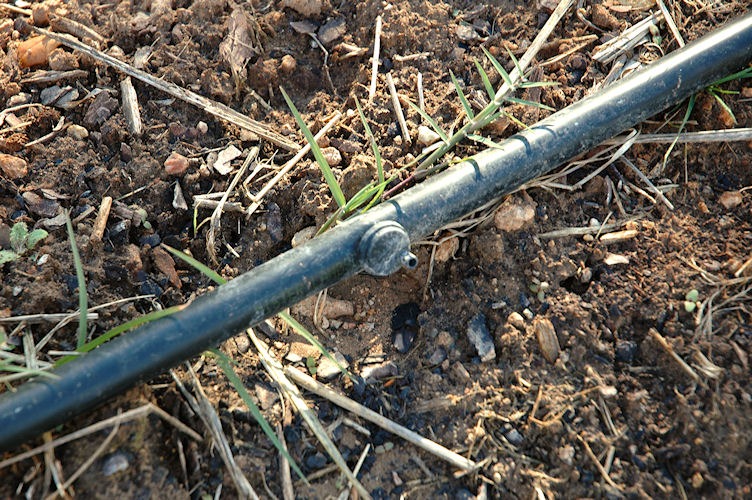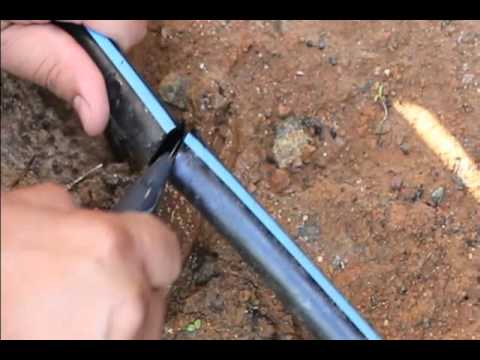To fix a hole in a drip line, locate the hole and cut out the damaged section, then insert a connector or coupling to reattach the line. Fixing a hole in a drip line is essential to maintain an efficient irrigation system.
When a hole occurs in a drip line, it can result in water wastage and ineffective watering of plants. To rectify this issue, it is crucial to identify the hole’s location and carefully remove the damaged section. In doing so, a reliable connector or coupling should be inserted to seamlessly reattach the line.
By following these steps, gardeners and homeowners can ensure their drip irrigation system remains in optimal working condition, leading to healthier and thriving plants.

Credit: www.installitdirect.com
How to Fix Hole in Drip Line in 5 Easy Steps
1: Common Causes Of Holes In Drip Lines
Common causes of holes in drip lines include tree roots and underground obstacles that can puncture the tubing. Wear and tear from environmental factors like sun exposure and weather conditions can also weaken the drip line, causing holes to form.
Accidental damage during gardening activities such as digging or mowing can lead to holes in the drip line as well. It is important to regularly inspect the drip line for any signs of damage or holes to ensure proper irrigation.
Fixing a hole in a drip line can be done by cutting out the damaged section and replacing it with a new section of tubing, making sure to secure the connections tightly. Regular maintenance and timely repairs are crucial for keeping the drip line system functioning efficiently.
2: Identifying The Location Of The Hole
To fix a hole in the drip line, it is crucial to first identify its location. Visual inspection is key to tracing the water flow along the line. Take note of any wet soil or puddles around the drip line, as these can indicate the hole’s location.
Alternatively, you can use a leak detection tool to pinpoint the exact spot of the leak. Once you have located the hole, you can proceed with the necessary repairs to ensure the proper functioning of the drip line system. Remember, prompt action is essential to prevent water wastage and maintain efficient irrigation.
3: Fixing Small Holes In Drip Lines
Fixing small holes in drip lines can be easily done with the right tools and equipment. Start by preparing the necessary tools and equipment for the job. Locate and mark the hole in the drip line, making it easier to repair.
Once located, repair the hole using a patch or epoxy. Make sure to follow the instructions on the patch or epoxy carefully. Applying the patch or epoxy will seal the hole, preventing any further leaks in the drip line. Keeping your drip line in good condition is important for maintaining an efficient irrigation system.
Regularly checking for and fixing any holes will ensure optimal performance and prevent water wastage. So, take the time to fix any small holes in your drip line and enjoy a well-functioning irrigation system.
4: Fixing Large Holes In Drip Lines
Fixing large holes in drip lines requires assessing the extent of the damage and replacing the damaged section. Begin by closely examining the affected area and determining the size of the hole. Next, carefully remove the damaged portion of the drip line, ensuring that you cut it cleanly and smoothly.

Once the damaged section is removed, obtain a replacement piece of drip line that matches the specifications of the original. Connect the new piece to the existing drip line, using connectors or couplings as needed. It’s important to ensure a secure and watertight connection.
After completing the repair, test the system to confirm that the hole has been fully fixed and there are no leaks. Run water through the drip line and monitor for any signs of water escaping. If all goes well, your drip line should be back to working efficiently, providing water to your plants as intended.
5: Preventive Measures To Avoid Future Holes
Preventive measures play a crucial role in avoiding holes in the drip line. Regular inspections and maintenance are necessary to identify potential issues. Using protective barriers and covers can safeguard the drip line from external damage. It is vital to follow proper installation techniques to ensure the drip line remains intact.
By adhering to these preventive measures, you can minimize the chances of holes in the drip line and maintain efficient irrigation. So, make sure to inspect, maintain, protect, and install accurately for a seamless drip line system.
Frequently Asked Questions For How To Fix Hole In Drip Line
How Do You Fix A Hole In A Drip Line?
To fix a hole in a drip line, first, locate the hole by inspecting the line for any visible leaks or wet spots. Once found, cut out the damaged section and insert a barbed repair connector. Secure the connector and ensure a tight fit to prevent any further leakage.
Test the line for any remaining leaks.
What Causes Holes In Drip Lines?
Holes in drip lines can be caused by various factors such as pressure fluctuations, physical damage, or degradation over time. High water pressure can lead to burst holes, while physical damage can result from improper installation, gardening tools, or animal disturbances.
Over time, exposure to sunlight and harsh weather can degrade the lines, causing holes to develop.
Can You Repair A Small Hole In A Drip Line?
Yes, small holes in drip lines can often be repaired. Use a hole punch or sharp knife to cut out the damaged section. Then insert a barbed repair connector into the hole, ensuring a tight fit. Secure the connection and test the line for any remaining leaks.
How Long Does A Drip Irrigation System Last?
A properly installed and maintained drip irrigation system can last anywhere from 5 to 25 years. The lifespan depends on various factors, including the quality of materials used, proper installation techniques, proactive maintenance, and the specific climate conditions the system is exposed to.
Regular inspections and upkeep can help prolong the system’s lifespan.
How Efficient Is A Drip Irrigation System?
Drip irrigation is highly efficient, using up to 50% less water than traditional overhead sprinkler systems. By delivering water directly to the root zone of the plants, evaporation and runoff are minimized. Additionally, the slow and precise nature of drip irrigation allows for better water absorption, reducing water wastage and promoting healthy plant growth.

Conclusion
To wrap up, fixing a hole in the drip line is a manageable task that can save you time, money, and water in the long run. By following the simple steps outlined in this blog post, you can identify the location of the hole, clean and prepare the area, and apply an appropriate patch or connector.
Remember to consider the size and type of hole, as well as the materials you need for the repair. Regular maintenance and inspection of your drip system is important to prevent future holes and ensure the efficient delivery of water to your plants.
By taking the time to address any issues promptly, you can enjoy a healthy and thriving garden. So, roll up your sleeves, grab your tools, and get ready to fix that hole in your drip line!

